The Schools Chancellor Must Step Up or Step Aside
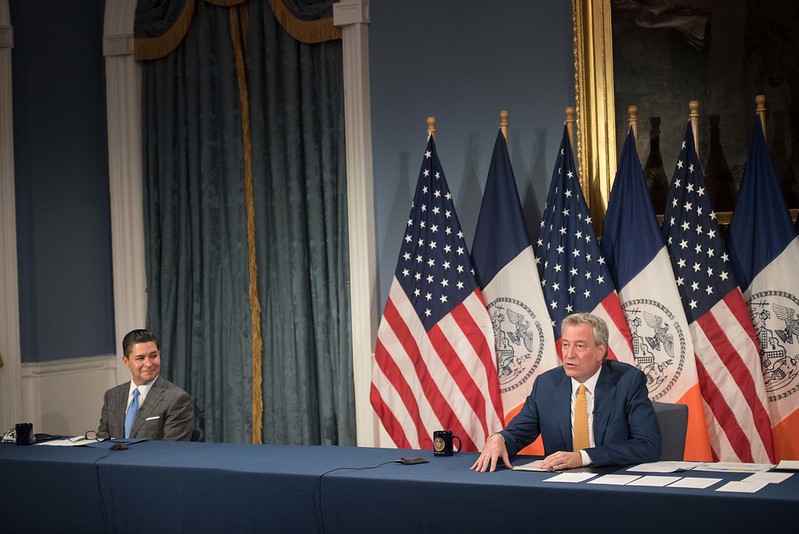
Mayor de Blasio & Chancellor Carranza (photo: Mayor's Office)
Unless there's an unexpected, immediate turnaround, New York City's public schools need new leadership.
Poorly planned March closures, Spring and Summer distance learning failures, and overwhelmingly confused reopening plans for Fall are evidence of a system in near collapse and the cause of widespread parent and teacher despondency.
This is not all Chancellor Richard Carranza's fault. He works for a Mayor who has been slow and stubborn throughout the city's pandemic response, especially when it comes to the schools. But Mayor Bill de Blasio still has a year and a half left in office and our schools need new leadership now. We need a new Chancellor who will stand up to the Mayor, demonstrating managerial decisiveness and instructional vision. Deferring to de Blasio at every turn is a calamity for our children who face a perilous educational future.
Mayoral control of the city's schools makes the Chancellor's independence difficult. But Police Commissioner Dermot Shea regularly challenges the Mayor and gets away with it. Education is no less a technical field than policing. Carranza, however, has shown little backbone to chart his own course over the past two-and-a-half years and especially for the past six months. He needs to step up or step aside for a stronger replacement.
There is little chance that de Blasio will remove the Chancellor, a loyal soldier. Some will question changing horses mid-stream. But when the water is rising and the Mayor with the Chancellor at his side are stuck, the only choice is to spur change. So, without new-found independence, it remains for Carranza to leave, allowing new leadership to move us forward.
Carranza's greatest and most lasting legacy has been calling out our system's structural racism. He dared utter the word "segregation" when it stuck in de Blasio’s throat. He called for dismantling screened schools. He appointed people of color and women to high positions. No Chancellor in history has been more forceful in their calls for a more just and equal school system.
Those words, though, have not been followed by sufficient action. Here again, perhaps held back by the Mayor, Carranza has not met the moment. He has lagged, rather than led, as a few community school districts made strides improving diversity. Screened schools still promote segregation. Implicit bias training has been overly expensive and of dubious effectiveness. Two reports by the School Diversity Advisory Group have largely been shelved, especially the most significant integration recommendations. Now, inequities accumulate in haphazard reopening plans and budget cuts visited on the most vulnerable. Having broken through on rhetoric, stronger leadership is required to turn verbal commitments into reality.
De Blasio ran out of educational gas with his inspired first burst of effort bringing truly universal pre-kindergarten to New York. But Chancellor Fariña merely reversed Bloomberg-era reforms and Carranza has shown little ability to make strides in either instruction or bureaucratic responsiveness. Many outstanding educators wait in the wings to bring extensive leadership experience, new energy, and independent ideas to our schools. Among them are First Deputy Chancellor Don Conyers, Rhode Island Education Commissioner Angélica Infante-Green, and ex-Montgomery County, Maryland Superintendent Josh Starr, who all have enviable track records within the New York City Department of Education and could immediately step into the Chancellorship.
If.
If de Blasio can suppress his arrogance and admit he is no educational expert, allowing a new Chancellor to choose his or her own team and set a course outside the political calculus of City Hall.
If Chancellor Carranza has the courage to step up or see that he has brought us to where we are but can go no further.
If we, under new leadership, can reclaim our sense of hope and confidence instead of fear and confusion about this traditional time of renewal, the new school year.
***
David C. Bloomfield is Professor of Educational Leadership, Law, and Policy at Brooklyn College and The CUNY Graduate Center. On Twitter @BloomfieldDavid.
***
Have an op-ed idea or submission for Gotham Gazette? Email This email address is being protected from spambots. You need JavaScript enabled to view it.
Eradicating Visible and Invisible Racism in Housing
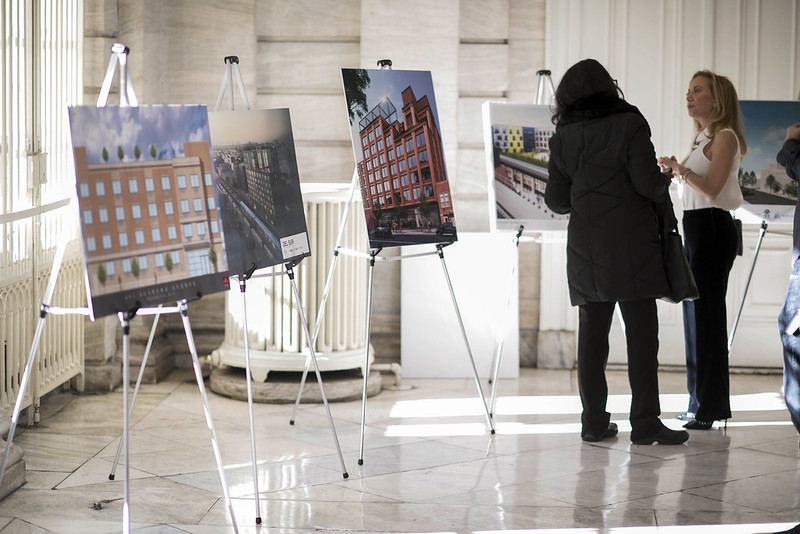
(photo: Ed Reed/Mayoral Photography Office)
“Segregation now, segregation tomorrow, and segregation forever,” declared Alabama Governor George Wallace in 1963. This racist trope pandered to white voters and could not have been clearer, just as recent remarks by President Donald Trump were to white suburban voters.
Trump contends that implementing an Obama-era federal housing department rule designed to assist all communities (not just suburbs) to meet their legal obligation under the 1968 Fair Housing Act to “affirmatively further fair housing” (AFFH) will “totally destroy the beautiful suburbs.” The president asserts that the AFFH rule would force communities to accept low-income housing which, in turn, would rapidly increase crime and lower property values. As numerous studies have shown, this is patently untrue. But to people who utter such racist nonsense, facts rarely matter.
We should not be surprised that a president whose business was prosecuted for alleged racial discrimination in housing in the 1970s does not believe fair housing laws should be enforced. Apparently, this self-described “law and order” president cherry picks the laws he wants enforced and our nation’s civil rights laws are not even on his list.
Housing and Urban Development (HUD) Secretary Ben Carson has also opposed the AFFH rule, stating that addressing the inequalities resulting from structural and historical racism would be a “waste of time” and dismissed the rule as “social engineering.” Ironically, he appears oblivious to the fact that it was a massive, intentional, coordinated, and costly social engineering effort over more than half-a-century by the real estate industry and government at all levels that constructed the architecture of residential racial segregation that remains so durable and visible in our metropolitan regions.
This legacy of discrimination, which explicitly preserved and protected white neighborhoods and white economic interests to the disadvantage and exclusion of African-American people, was responsible for creating the racial wealth gap that persists to this day. Congress included the duty to affirmatively further fair housing in the Fair Housing Act to ensure that, going forward, the federal government and recipients of federal funds would take meaningful steps to ensure that housing and community development policies and programs reduced residential racial segregation and repaired the harm caused by past government action. This administration’s action to set aside this rule and eviscerate a key provision of the Fair Housing Act must not be allowed to stand.
As a nation, we also need to eliminate less visible forms of systemic racism in housing that persist to this day. The late civil rights leader James Farmer Jr. stated, “Institutional practices, it seems, perpetuate themselves mostly by their invisibility.”
In November 2019, Newsday released the results of the largest journalistic testing investigation into real estate practices conducted in the nation. Newsday documented racial steering and found that, nearly half of the time (49%), African-American home-buyers experienced racial discrimination when searching for a home to purchase on Long Island. In July 2020, Suffolk University Law School reported on the results of an undercover testing investigation completed in the Boston area that found Black renters encountered less favorable treatment than their white counterparts 71% of the time. Decades of testing investigations conducted by fair housing organizations provide compelling evidence that systemic racism remains a persistent and pervasive characteristic in our metropolitan housing markets. But the subtle nature of contemporary housing discrimination makes it virtually impossible for ordinary consumers to detect.
Government enforcement of fair housing laws has been largely passive and uneven over the past 52 years. Past Republican and Democratic administrations can be roundly criticized for treating fair housing with abject neglect. But the Trump administration has mounted an overtly racist attack on fair housing by advancing two destructive regulations, one that provides an utterly fatuous redefinition of what it means to affirmatively further fair housing and another that makes it virtually impossible to use the well-established legal theory of disparate impact to enforce fair housing laws. Repairing the damage this administration has done to our fair housing laws will require that the next administration rescind these vile regulations as part of a larger racial justice agenda.
In a recent Los Angeles Times op-ed, Kareem Abdul-Jabbar powerfully wrote, "Racism in America is like dust in the air. It seems invisible — even if you’re choking on it — until you let the sun in. Then you see it’s everywhere. As long as we keep shining that light, we have a chance of cleaning it wherever it lands. But we have to stay vigilant, because it’s always still in the air."
As a nation, we must shine a bright light on discriminatory housing policies and practices and work to cleanse our housing markets of pernicious systemic racism. This will mean devoting significant resources to vigorously enforce and fully implement fair housing laws. If this is going to happen, our first cleaning project should be the White House.
***
Fred Freiberg is Executive Director of the New York City-based Fair Housing Justice Center.
***
Have an op-ed idea or submission for Gotham Gazette? Email This email address is being protected from spambots. You need JavaScript enabled to view it.
Statements Aren’t Enough; We Must Center Racial Equity in the City Planning Process Now
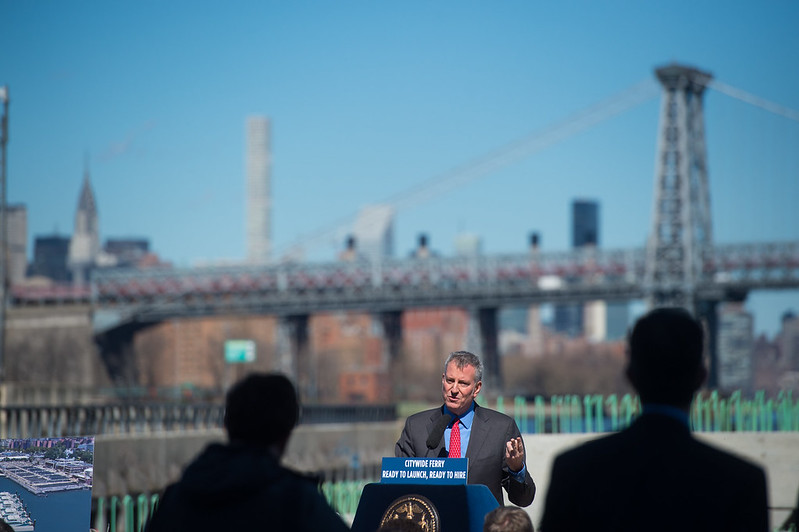
(photo: Edwin J. Torres/Mayoral Photo Office)
This is a pivotal moment in our city. As the disparate impacts of COVID-19 and the vital urgency of the Black Lives Matter movement make clear, New York City government needs a fundamental course correction, one centered on racial equity and undoing the damage of decades and centuries of injustice. Though the need for reform stretches across all our institutions, those that decide our built-environment play an especially crucial role. These agencies must reckon with a legacy of practices that have perpetuated systemic racism, hurt quality of life, and denied opportunities to communities of color.
City planning and the land-use process serve as a reflection of our city’s values and priorities. If racial equity is truly a priority for our city then a cultural shift in planning is needed, beyond a single institution or the ULURP process, to address a stubborn developer-centric approach that privileges capital over community. At the heart of this culture shift is rebuilding trust with New Yorkers that have been hardest hit. City government cannot simply repackage its current approach of rezoning low-income communities of color in the name of equity. At this crucial moment in our city and country, we need to do better.
Centering racial equity in the planning process would mean ensuring an equitable distribution of resources and development city-wide. Decisions would be based on needs like infrastructure and challenges like climate change and the risks of displacement, instead of a transactional approach based on a community’s political power. It would mean moving away from an approach that sees adding units as the sole indicator of a successful housing policy, without taking into account displacement, community wealth building, or racial equity. It would mean supporting and approving community plans that address both local and city-wide goals, and learning to build trust in that process.
Taking a color blind approach to planning, as many of our agencies do today, is not enough. We may not be using the same explicitly racist tools of the past, but for many communities, the outcomes are the same. In the absence of explicit racial-equity priorities, white residents and white communities with more resources and connection to power will always benefit the most. As the primary drivers of planning in the city, both the New York City Department of City Planning and Economic Development Corporation acknowledged the importance of addressing these challenges. While the statements are a necessary first step, they are not enough on their own.
The good news is that some of our institutions are already taking initiative to actively address historical injustices. For example, the City Parks Department developed the Community Parks Initiative. Centered on equity, this process helped the agency identify historically underserved parks in poorer neighborhoods - using dedicated funding to build new parks, improve programming, and increase operations to bring meaningful changes to open space and surrounding communities. Similarly, the City Health Department launched its Race to Justice effort several years ago to examine how structural racism impacts its work, helping it to develop staff knowledge and skills, new policies, and to collaborate with communities through an anti-racist lens.
The City Department of Housing Preservation and Development has shown what a good community planning process can look like, by working collaboratively with the Edgemere community after Hurricane Sandy to develop a community plan with 60 recommended projects, many of which have been funded. And in 2017, two local laws (60 and 64) were passed requiring the city to develop an environmental justice plan, which when complete will advise agencies and city leaders on the steps needed to address the environmental burdens low-income communities of color across the city have had to face, including strategies to improve health equity and deliver opportunities to expand the green economy. These examples show that New York City government is already working to undo a history of racist planning policies, although in a piecemeal way. We need to build on this.
When low-income communities of color push back on city-led plans, they must be listened to, not dismissed as being anti-change. When neighborhoods come together to craft a community plan that centers their values, while still addressing city-wide goals, city government should help realize their plans. And on the flip side, wealthier and whiter neighborhoods must no longer be off-limits for the types of increased density and development the city has prioritized in low-income communities.
We can make this shift by implementing a comprehensive planning approach that centers racial equity. One that commits not just words, but scarce money, time, and technical resources to ensure our institutions work in collaboration with each other and the communities they serve to lessen and reverse the impacts of historical and structural racism. Let’s get to work.
***
Maulin Mehta is Senior Associate of State Programs and Advocacy at Regional Plan Association. Christopher Walters is Rezoning Technical Assistance Coordinator at Association for Neighborhood and Housing Development. Both organizations are members of the Thriving Communities Coalition.
***
Have an op-ed idea or submission for Gotham Gazette? Email This email address is being protected from spambots. You need JavaScript enabled to view it.
Save Our School Children: Give Them Philosophy
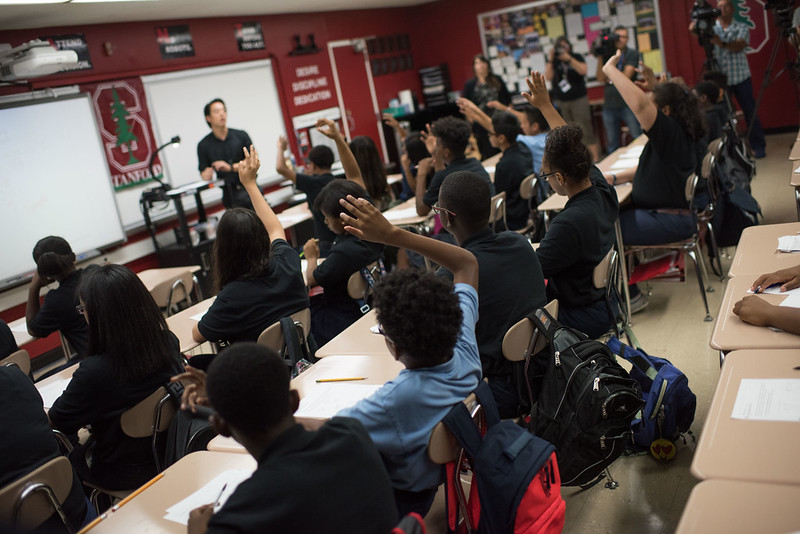
(photo: Michael Appleton/Mayoral Photography Office)
The question of how to resume our children’s education safely has understandably preoccupied parents, educators, and elected officials. And because the difference between the various models being proposed (‘blended’ vs fully remote) may well be the difference between life and death for a fellow human being, we need to rely on the best available science.
Yet the question of ‘how’ to restart school for the city’s 1.1 million public school students is not the only one we need to be asking. Two others that demand our attention are what they will learn and why. And because answers to these questions are essential to determining how well our children’s lives are to be lived, we need to turn to philosophy.
What students need to learn is how to think. That may sound obvious but what most students learn in school is not how to think but what to think. Instead of exercising their minds by exploring the many possible ways to be human, they quickly learn the value of knowing what is expected of them, what to repeat back, and what they need to do to pass the next test.
Rather than finding school to be a safe space for young minds to try out big ideas, too many students come to see school as a purgatory they must pass through before they take their pre-assigned role in a rigged game where success is measured by material gain. To allow such cynicism to take root is not to educate young souls but to impoverish them.
Learning how to think begins with the realization that the most interesting and important questions in life are not black and white but grey, not resolved with a google search or by asking Siri but are necessarily open-ended. That means not only that they can be answered in several, often incompatible ways, but that those various answers reliably raise a multitude of new questions of their own.
These include so-called ‘big questions’ such as “What is fair?,” “Do we have free will?,” and ‘What is truth?,” but quickly extend to what appear to be more pointed questions, such as “When is government coercion justified?,” “Is adequate housing a right?,” and “What is the purpose of an education?”
These are philosophical questions and they are the kind of questions that humans have been asking in one form or another for ages. The different answers that have been given at various times and places have shaped our history and have helped define our cultural identities. The answers we settle on give meaning to our lives by framing the choices we make concerning ourselves, our families, and our communities. The answers we try to live by determine how we deal with our failures and how we face our deaths. It is by learning how to think through these fundamental questions that humans learn how to live.
As every parent knows, philosophical questions come naturally to children. Still new to the world, the young can’t help but wonder who they are and who they might yet become. They are desperate to know what is possible, what is not, and why.
We need to encourage them in their quest to understand the human condition. Besides being intrinsically enjoyable, their philosophical investigations will improve their critical thinking, deepen their emotional intelligence, and lead them to be respectfully open-minded about diverse viewpoints. Making time for philosophy will also increase their understanding in math and reading.
Given the value and benefit of providing young minds the time and space to grow, we ought to be placing a philosopher-in-residence in every school to facilitate student’s intellectual journeys. We should be allowing them to ask if animals have rights, if robots can be persons, and whether prisons should be abolished. We should be encouraging them to articulate answers that make sense to them and to attentively listen to their classmates who do not agree.
But rather than make such discussions central to our children’s education, we too often dismiss their big questions as irrelevant and a distraction to the lessons we unreflectively think they need to learn. Little wonder that as children grow older they ask these important questions less and less.
And this points to the most important reason why we need philosophy in our schools, to ensure that when our children grow up they will be less like ourselves. Most people only encounter philosophy in college, if it all, which helps explain why so many adults don’t know how to think either. If we did, perhaps we would be leading happier, more fulfilling lives than we currently do.
If we learned to contemplate different alternatives and perspectives about how to live, then perhaps we would be able to converse respectfully with each other about matters on which we disagree. If as children we had been encouraged to think deeply about the difference between wants and needs, then perhaps New York City and its school system for which we are now responsible wouldn’t be as inequitable and painfully unjust as they are.
Our young people, certainly those of middle- and high-school age, are not so self-absorbed that they fail to realize that the way things have been is not only unacceptable, but that it is falling away. The arrival of the coronavirus and the tragic disruption that it has caused, coupled with a summer of social upheaval sparked by the killing of George Floyd and fueled by centuries of suffering and oppression, has forever altered the perspectives of this current generation of students. They want something better, something more just and more hopeful than the city and the lives they currently stand to inherit. We need to give them the tools to conceive what that something better might be, as well as the confidence to go forth and create it. Their lives depend on it.
***
Joseph S. Biehl, PhD, is the founder and executive director of the Gotham Philosophical Society and Young Philosophers of New York. On Twitter @jsbiehl.
***
Have an op-ed idea or submission for Gotham Gazette? Email This email address is being protected from spambots. You need JavaScript enabled to view it.
Homelessness, Housing, and the Upper West Side
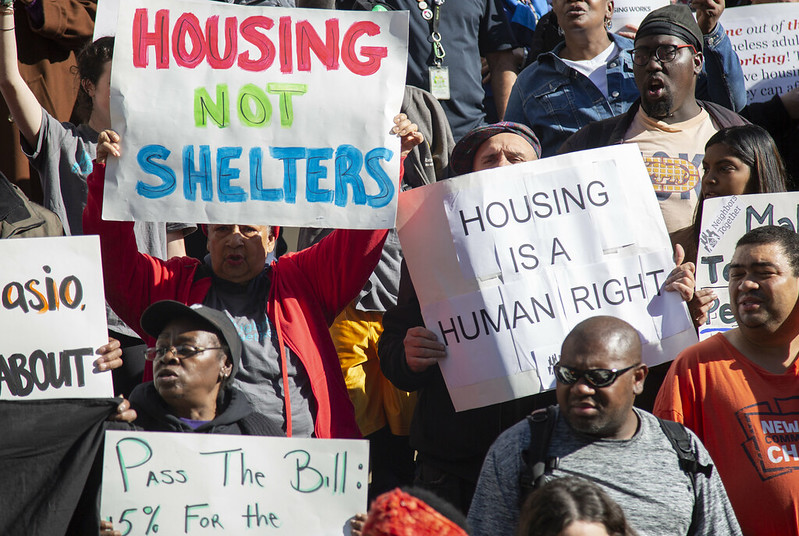
(photo: John McCarten/City Council)
I spent a good portion of my childhood and adolescence around the intersection of West 79th and Amsterdam, whether it was with my parents or friends’ parents at Bagels & Co., or picking up snacks at the Duane Reade or Insomnia, or covertly eating non-kosher at Island Burgers. So it has been deeply saddening for me to see such a cornerstone of my neighborhood be turned into a rallying cry for reactionary hatred. The temporary sheltering of a few hundred homeless people in the Lucerne, the Belleclaire, and the Belnord is the least that the Upper West Side, one of the wealthiest neighborhoods in the Western Hemisphere, can do. Especially when the alternative is overcrowded, understaffed city shelters where COVID-19 could spread easily.
That’s the reality that seems to be lost on groups like Upper West Siders for Safer Streets, a Facebook page whose members have called for, among other things, smearing excrement on city benches to keep away homeless people and using fireworks to clear out homeless encampments: that we are living in extraordinary times. Just this weekend, America passed 5 million covid cases and 150,000 covid deaths. If otherwise-empty hotels can be used to help reduce covid vulnerability of existing shelters, then it should be done. With shelters recording a 60% higher rate of infection over the city, as Pablo Zevallos wrote last week, “social distancing...is a life-or-death matter for the homeless.”
Admittedly, plenty of my neighbors do understand this. They instead argue that they are being forced by the city to sacrifice their community for the sake of health. And to these people I have to ask: what sacrifice? According to NYPD data, crime on the Upper West Side is either flat or down year-over-year across all categories. By any metric, the Upper West Side remains the safest neighborhood in Manhattan. Just this weekend I passed by two Guardian Angels on the corner of my block, a block on which I have never, in my entire life, been witness to a crime. Contrary to the apparent beliefs of many members of the Safer Streets Facebook group, not every person of color you don’t recognize is homeless, nor are they committing a crime.
There is a growing sentiment among my neighbors, though, that being homeless is in-and-of-itself a crime. Whether people realize it or not, this is the sentiment behind worrying about, for example, public urination (real quick, give me the location of a 24-hour public restroom on the Upper West Side). My point here is not that public urination is a desirable outcome - of course it isn’t. It is, however, the natural consequence of having a very large population of homeless people and few public restrooms. Bear in mind, too, that New York is the only city in the country with a right-to-shelter law, which stipulates exactly what the name suggests: the city is required by law to house everyone. COVID-19 aside, there have never been enough shelters to fulfill this requirement, so the city has turned to hotels. Again - housing homeless people in hotels is not a desirable outcome, but it is the natural consequence of not having built enough housing.
And this is an area where our neighborhood has clearly failed. I’ve always found it funny that Mayor de Blasio is blamed for everything bad that happens on the Upper West Side when his housing policy has left our neighborhood virtually untouched. Since 2014, the city has constructed just one affordable building north of 62nd Street. This is not because of the high cost of housing on the Upper West Side. Aaron Carr, founder of the Housing Rights Initiative, pointed out that the city’s own report on affordable housing found that expensive markets are actually better for affordable housing construction. This way, private developers can more easily defray the cost of affordable units with more expensive, market-rate units. So why, then, has the city built so much affordable housing in lower-income neighborhoods like East Harlem and Bedford-Stuyvesant and nothing in higher-income neighborhoods like the Upper West Side? The Lucerne is the answer. As Carr put it: “The backlash against the hotels is part of a broader pattern of exclusion.” Upper West Siders do not want new housing, so no new housing has been built.
But there is no other way to resolve this crisis. Shelter is, quite literally, the most basic human need, and there is no other way to help homeless New Yorkers get their lives back on track. It is high time that neighborhoods like the Upper West Side, wealthy even by the standards of the richest city in America, contribute to ending our housing crisis. That’s why I’m an active member of Open New York, a group fighting to bring more housing to wealthy neighborhoods so that more people can afford to live in New York City.
We’re currently working to upzone SoHo, but the same arguments apply equally well to the Upper West Side. More housing in the wealthiest neighborhoods will create more funding for affordable housing, increase integration, and take displacement pressures off vulnerable, less-privileged areas of the city. We live in a neighborhood that millions of Americans can only dream of: good schools, safe streets, and beautiful parks, right in the heart of the economic engine of the world. Instead of building walls around what we are fortunate enough to have, we should open our doors and give others the chance to share in it.
***
Jonathan Lindenbaum is a lifelong Upper West Side resident and member of Open New York. On Twitter @urbaneurban.
***
Have an op-ed idea or submission for Gotham Gazette? Email This email address is being protected from spambots. You need JavaScript enabled to view it.
Should New York City Cut School Bus Service?
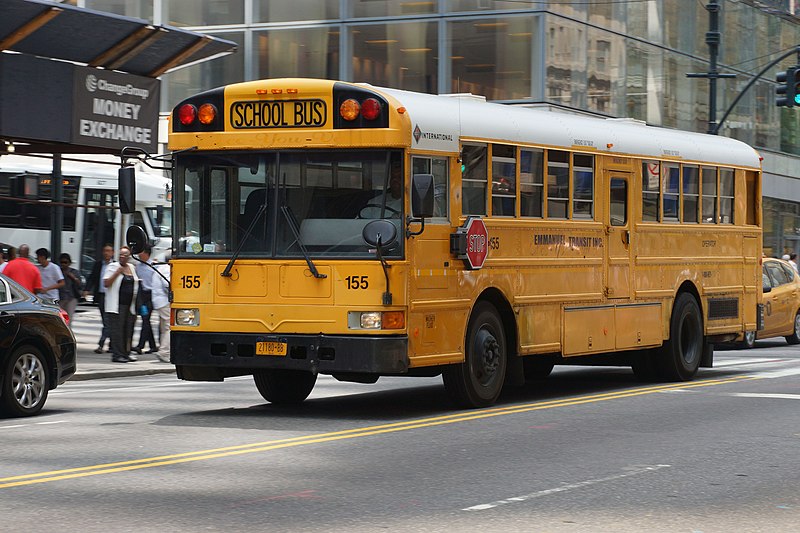
A school bus in the city (Wikimedia Commons)
Challenged by reduced bus capacity due to social distancing and strained budgets, school districts face difficult decisions about school busing this fall. How can districts allocate scarce busing resources to best support students? Some districts, like Dayton, Ohio, are considering eliminating bus service for charter schools. Others would go farther, proposing to limit bus service to students for whom it is legally mandated -- those with Individual Education Programs (IEPs) and those living in temporary housing -- leaving other students to walk, use public transit or private transportation.
Our work suggests that the impact of such cuts would fall disproportionately on low-income, Black, and Hispanic students, and reduce educational opportunity for students living in disadvantaged neighborhoods. Although cutting school bus service may seem like an “easy” way to save money, educators and policymakers should wield the budget knife carefully.
Buses are Important
While many downplay the importance of school buses in cities with high density and robust public transportation systems, our work in New York City highlights the significant role school buses play in urban districts. School buses transport students with disabilities to appropriate schools, help children living in temporary housing avoid the disruption of transitory school changes, transport students who live far from their neighborhood school, and enable low-income children in disadvantaged neighborhoods to access higher quality schools (including charters).
All Kinds of Students Take the Bus
According to 2017 ridership data, more than 115,000 K-8 public school children take a school bus in New York City. Nearly half have bus service mandated as part of their IEP or under the federal McKinney-Vento Act, which requires districts to provide homeless students with transportation to their origin school. Eliminating bus service for these students is neither legal nor desirable.
The remaining 60,000-plus students who take the bus are eligible for service because they live outside their school’s “walk zone” – a half mile for students in grades K-2, a mile for students in grades 3-6, and 1.5 miles for grades 7-8. These students are also offered the option of a Metrocard, which allows free use of public transit, but choose to ride the school bus instead. They include a racially diverse mix of students from all five boroughs, and a majority are from low-income households.
Roughly 60 percent of school bus-riding students attend a charter or magnet school or another neighborhood’s zoned school that offers a preferred program. Among these “choice school” students, those who ride the bus are significantly more likely to attend a ‘better’ school (with higher performing students) outside of their neighborhood than students attending choice schools close to home. These students are disproportionately Black and Hispanic, suggesting the school bus serves to reduce racial/ethnic disparities in access to good schools.
Where to Find Savings?
Let More Kids Walk
New York City can expand current walk zones to match those used by other large urban districts. In Baltimore, Boston, and Philadelphia, for example, even the youngest students must live more than a mile from school to receive bus service and older students more than 1.5 miles. If New York City followed suit, expanding the walk zones to one mile for K-2 students and 1.5 miles for grades 3-6, the number of school bus riders would drop by roughly 35 percent.
Let Older Students Rely on Public Transit
Most students living outside the middle school walk zone are only offered Metrocards and not school bus service, with options often determined by the school principal. Accordingly, roughly four out of five middle school students who live outside the walk zone already use public transit. Eliminating the bus for middle school students would decrease bus ridership by approximately 10,000 students.
Eliminate Busing to Charter Schools
Students attending charter schools currently receive the same bus service as students attending traditional public schools and are subject to the same eligibility rules. Expanding walk zones would reduce the number of charter school students taking the bus, but a sizable number would still live far enough away to be eligible for bus service. Eliminating bus service to charter schools entirely – as Dayton is considering – would reduce bus ridership by about 20 percent, roughly 90 percent of which would be Black or Hispanic students.
Assessing the Costs and Benefits
While the direct financial consequences of reducing school bus service may be clear, there will also be a set of unintended benefits and, inevitably, costs. As for benefits, reducing bus service may encourage more students to walk or use “active transportation,” such as biking or skateboarding, with positive effects on physical activity, time spent outdoors, and reductions in obesity.
As for costs, reducing bus service may increase reliance on public transit, which could expose students (or other riders) to an increased risk of COVID-19. In another vein, whether students walk or use transit, the lack of supervision on the commute may pose additional safety risks. Finally, families faced with difficult commutes to a choice school may be compelled to move their child to a school close to home, causing educational disruption and, potentially, a less appropriate educational setting for their child. These losses are likely to be particularly large in low-income Black and Hispanic communities already hard hit by COVID-19.
Weighing the benefits and costs is difficult because of so much uncertainty around transmission and the modality of instruction in the fall. Our take is that, on balance, eliminating all service to charters would entail substantially higher educational costs than expanding the walk zone. Reducing the availability of school buses to middle schools is also appealing, particularly because larger walk zones would significantly reduce the number of students who would even be eligible. Of course, exceptions will have to be made to accommodate unusual individual circumstances, such as hazardous walking routes. For many students, however, getting off the bus would be neither onerous nor detrimental to their education. It may even do them some good.
***
by Amy Ellen Schwartz, Sarah Cordes, Jeffrey Zabel & Christopher Rick.
Schwartz is the Daniel Patrick Moynihan Chair in Public Affairs at Syracuse University, Professor of Economics and Public Administration and Director of Transportation Research at the IES funded REACH Center.
Cordes is an Assistant Professor of Policy, Organizational, and Leadership Studies at Temple University and a Research Partner with the IES funded REACH center.
Zabel is a Professor of Economics and Co-Director of the MS Program in Data Analytics at Tufts University. He is the Co-Editor of the Journal of Housing Economics.
Rick is a doctoral student in public administration at the Maxwell School, Syracuse University.
***
Have an op-ed idea or submission for Gotham Gazette? Email This email address is being protected from spambots. You need JavaScript enabled to view it.
Mayor Must Bridge Budget Gap Without Borrowing or Mass Layoffs
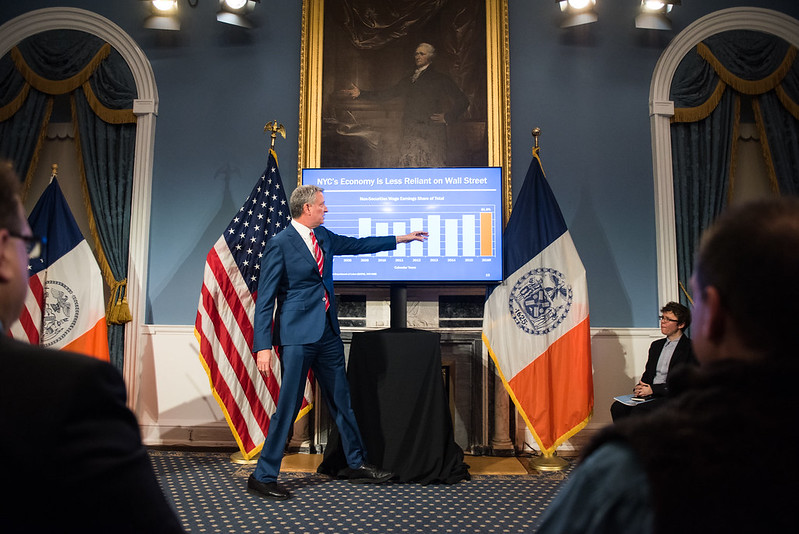
(photo: Edwin J. Torres/ Mayoral Photo Office)
Despite a full-court press from cities and states across the country, Congress left for August recess without passing joint legislation to provide them with federal financial assistance. This aid is desperately needed by localities, both red and blue, that have suffered dramatic revenue losses due to the shutdown of much of their economies during the pandemic. There is still hope that some amount of aid will eventually be forthcoming, but not in time or in sufficient amount to address the dire needs of New York City and State.
While the current fiscal year budget for the city is technically balanced, it includes some big risks, such as large police overtime reductions that are often attempted but never achieved and a $1 billion target for labor savings with no details or signs that any real discussion is taking place. The projected deficit for next fiscal year is $4.2 billion. So the likelihood is that the combined two-year deficit is close to $6 billion, maybe more.
But Mayor de Blasio has delayed taking action to address the gap until October, hoping that federal funding would come through in the meantime. As that prospect looks more and more unlikely, he has taken to warning that 22,000 layoffs will be necessary unless the city is given permission by the state to borrow money to cover the shortfall; to make the threat more real and compelling to legislators, notices of the number and savings value of possible layoffs by agency are scheduled to be released on August 31 and there have been leaked reports of dire consequences such as layoffs of hundreds of EMTs and thousands of teachers.
The mayor bristles at comparisons of the current situation to the 1970s when the city relied so heavily on financing its expenditures that it got to the point when no one would loan it any more money. Yes, the reason for the revenue shortfall now is different. Then, it was a problem of spending persistently exceeding resources; now it is a dramatic and sudden loss of revenue caused by an unanticipated health calamity. But the result is the same: the city is not generating enough tax revenue (or state and federal aid) to pay for all its costs. And while we can and should be bullish about the city’s resiliency, there is reason to believe that its economic recovery will take several years at best; and the size and nature of the economy may be quite different than what it was before everything changed in March.
Borrowing for the next two years will not solve the problem, but only exacerbate it, because if there is insufficient revenue to cover expenses, more borrowing will be required and so on. Taxpayers of tomorrow will be paying hundreds of millions of dollars of debt service for bad decisions of today. It took until 2008 for the debt incurred to save New York City from bankruptcy in the ‘70s to be finally retired. The mayor has said that to keep debt service payments manageable he would cut capital spending (the only valid purpose for financing), a decision that could curtail high-priority infrastructure investments that are important to the city’s revitalization.
Unlike in the ‘70s, the state is not in a position to backstop the city by stepping in to take over its debt as it did then by creating the Municipal Assistance Corporation. Indeed, New York State is in even worse financial straits than the city, with skyrocketing Medicaid and unemployment insurance costs, not to mention the MTA on the brink of disaster.
What is needed are thoughtful, strategic spending reductions, not the across-the-board layoffs the mayor is threatening. The Citizens Budget Commission and other experts have come up with a number of valid suggestions including reductions in the cost of fringe benefits and productivity improvements. Public employee unions can be especially helpful in agreeing to compensation and work-rule and staffing changes so that all savings do not result in reductions to services to residents. No ideas should be shelved out of the belief that union opposition would be insurmountable; now is the time for doing what conventional wisdom would say is impossible. A serious, good faith effort by the de Blasio administration, the City Council, and public employee unions, working together to use a scalpel, not a hatchet, can significantly reduce costs and minimize the amount, if any, of borrowing required.
Let us be clear: our opposition to borrowing to pay operating expenses is not driven by a small government ideology. Rather it arises from a commitment to strong, secure, well-managed government and a desire to avoid even worse austerity measures that will come if we don’t make politically difficult but necessary decisions now.
Both the City and State Comptrollers, as members of the New York State Financial Control Board and as fiscal watchdogs, have an obligation to state clearly and unequivocally that borrowing our way out of the current crisis with no conditions or requirements for spending discipline (i.e. a reinstatement of the oversight and control powers of the Control Board) is not viable and should not be permitted. If they and legislative leaders Speaker Carl Heastie and Majority Leader Andrea Stewart-Cousins cave to pressure from public employee unions and others who don’t want to take responsibility for managing through the crisis, they will be complicit in kicking the can down the road and will bear the responsibility for the even more draconian actions that will need to be taken under the next mayor.
***
Carol Kellermann was president of Citizens Budget Commission from 2008 through 2018. Norman Steisel was a First Deputy Mayor of New York City, Sanitation Commissioner, and First Deputy Budget Director, all between 1974 and 1994.
***
Have an op-ed idea or submission for Gotham Gazette? Email This email address is being protected from spambots. You need JavaScript enabled to view it.
The Climate and Economic Plan for New York City’s Future That We Need Now
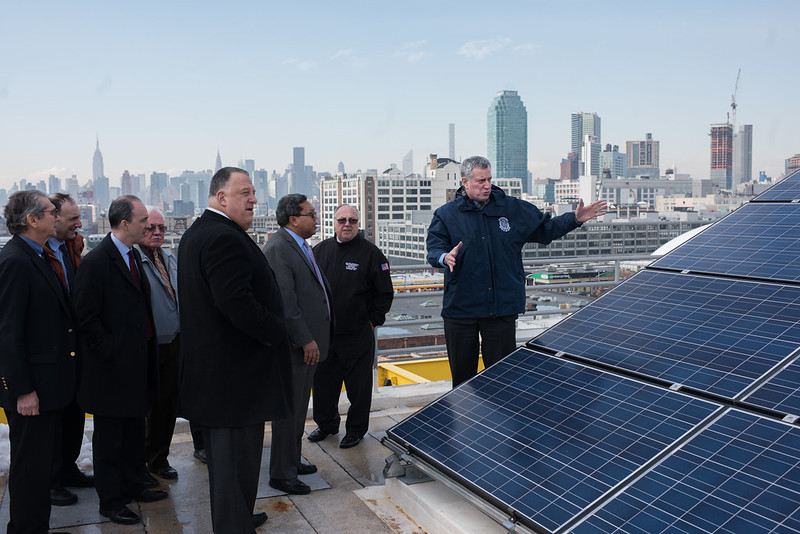
(photo: Michael Appleton/Mayoral Photography Office)
In March, I found myself with a 104-degree fever on my 18th birthday. My dad wasn’t faring any better, requiring a hospital visit and remaining sick for 12 days. After testing positive for COVID-19, we knew to stay isolated for 14 days once symptoms subsided, which was when my dad decided to get back to work. However, the economy decided against it.
He and his IBEW Local 3 brothers and sisters, along with thousands of other building and construction trade union members, saw job sites grind to a halt. From bodegas to banks, much of the business capital of the world quickly shuttered.
As a young person, I’m forced to reckon with a number of urgent crises: the destruction wrought by the COVID-19 outbreak, an economic recession, systemic racism, and climate change. We need a solution for New York City that addresses all four urgently.
As a New Yorker, 2020 hasn’t been easy – every day seems to bring more bad news. From March to August, we watched as tens of thousands of our neighbors died at the hands of COVID-19, the economy plummeted, and the city erupted in protests against racism. We’re still in the thick of crises. Nationwide COVID cases are on the rise, local unemployment is at more than 20%, and we’re inching towards the ‘point of no return’ for global warming. And yet, somehow, New Yorkers are expected to pay the rent.
While New Yorkers are suffering, it’s important to note where the current political climate intersects with the economy. The demands of the Black Lives Matter movement don’t end with police reform, but total economic and social parity for Black Americans. The statistics are startling: BIPOC unemployment is 2-5% higher than white unemployment while Black workers make under 60 cents on the white workers’ dollar. Now emerging from the pandemic, our most vulnerable neighbors cannot afford to return to ‘normal.’
New York City needs a local stimulus to get us through the pandemic while positioning the economy to be more robust and equitable, helping workers like my dad.
For years, the Climate Works for All coalition, a collection of local labor, environmental, and social justice groups, has been fighting for a ‘just transition’ to a sustainable climate and a fair economy. Since the COVID-19 crisis began, the coalition has developed the Climate and Community Stimulus Platform, a climate jobs recovery plan that outlines citywide infrastructure projects, putting 100,000 New Yorkers back to work and moving us towards our climate goals.
The platform continues green work already in progress throughout the city while also building new industries and making older sectors energy efficient. To expand upon Local Law 97, which requires a reduction in building carbon usage across the city up to 80% by 2050, the plan proposes funding for low-income and NYCHA housing retrofits. Small, midsize multi-family, and larger public housing units will all require some level of city funding to effectively meet Local Law 97 guidelines, and there’s no time like the present to begin this work. Using federal, state, NYSERDA, and local funding streams, we can raise the capital needed to hire thousands of workers as our city hits peak unemployment, building green infrastructure that will pay dividends for all New Yorkers for years to come. With local hiring promises and project labor agreements (PLAs), workers will be afforded safe and dignified jobs in their communities.
The Climate and Community Stimulus Platform also promotes bringing old sectors, such as transportation and manufacturing, into the 21st century green economy. Increased funding to electronic vehicle charging stations and MTA improvements would allow our city’s transportation infrastructure to meet the demands of its population. Funding for port development and electrification will help reinvigorate New York City’s manufacturing industry and promote local blue-collar job creation. It will bring the New York harbor to the forefront of the offshore wind industry, creating hundreds of new manufacturing and staging jobs.
Workforce development programs would support these projects by training workers for a green economy and the new jobs that come with it. Investments would also prioritize underserved minority communities, who have been disproportionately impacted by the COVID-19 crisis and resulting economic recession.
The proposal has had buy-in from all aspects of the policy field, from unions like IBEW Local 3 and IUPAT District Council 9 to environmental organizations such as the Sierra Club and New York Renews, and community groups like Make the Road New York and UPROSE. We’ve also included the voices of future generations of New Yorkers by working with TREEage, a youth climate justice organization that has been involved with the youth climate movement and Climate Strike NYC.
It is time for immediate action before these overlapping crises worsen, and the New York City Climate and Community Stimulus Platform is the tool we need to protect New Yorkers before a second wave.
***
Scott Siegel is co-policy director at TREEage, a youth climate organization based in New York City. On Twitter @scottsiegelny.
***
Have an op-ed idea or submission for Gotham Gazette? Email This email address is being protected from spambots. You need JavaScript enabled to view it.
As New York City Continues on Path to Recovery, City Officials Must Take Action to Protect Good Construction Jobs
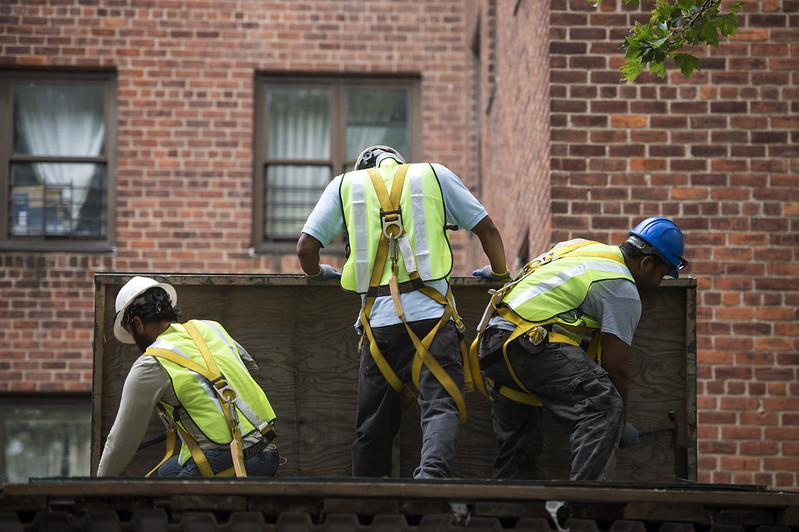
(photo: Demetrius Freeman/Mayoral Photography Office)
Residents and businesses across the five boroughs continue to struggle as New York City begins the long process of economic recovery from the impacts of COVID-19. At times like these, it is the responsibility of city officials to not only create new opportunities but also to protect and sustain the jobs we have.
That is why, amid all the much-needed public discussions around workers in hard-hit sectors, the construction industry – which employed approximately 160,000 workers across New York City as of 2018 – must be part of the conversation, particularly as we currently face a major problem that threatens to leave thousands of the city’s construction workers unemployed.
New York City Local Law 196, which first required a minimum of 30 hours of training in 2019, now mandates that construction workers receive an additional 10 hours of Site Safety Training (SST) by September 1.
The problem is that with the deadline just one week away, it is increasingly obvious that a significant number of construction workers in our local workforce development network have not been able to receive the SST they need. While this is an unintended consequence of the city’s well-intentioned effort to support safety in New York’s construction industry, the current September 1 deadline must be adjusted so that every worker can get the additional 10 hours they need to remain employed.
New York City Department of Buildings (DOB) Commissioner Melanie La Rocca stated at a recent City Council hearing that the agency has “no objections to a Council proposal to delay the current September 1 deadline. This position builds on the strong precedent set by DOB when it comes to adjusting Local Law 196 deadlines to protect jobs for construction workers.
When the law was first implemented, DOB officials recognized that thousands of workers at that time did not have the 30 hours of training required in advance of the initial deadline of June 1, 2019. That is why the 30-hour deadline was pushed back and did not take effect until December 1 of that year.
As members of non-profit and workforce development groups from across New York City, we have heard about this issue directly from many of our constituents and workforce partners – and we are calling on DOB to formalize this decision as quickly as possible.
To be clear, this is not the fault of workers or their employers. Like basically everything else in New York City, SST providers were forced to shut down all of their training operations throughout the spring due to the pandemic – and many of these courses are still unavailable. Virtual SST courses do exist, but they have been so few and far between – not to mention deeply underfunded due to city budget challenges – that it is not possible to get every construction worker in the five boroughs trained by September 1.
Simply put, this means that all of the workers who have not been able to receive the additional training will lose their jobs. Their families will lose the income they need to pay for rent, food, healthcare, and any number of other essential components of their lives.
Everyone agrees that safety training for construction workers is important – but in these unprecedented times, we must not let city bureaucracy get in the way of sustaining employment for thousands of local residents in one of our largest and most economically vital industries. We hope DOB will take the next step by ensuring that this deadline is delayed and that jobs are protected.
***
David Meade is executive director of Building Skills New York; Jennifer Mitchell is executive director of The HOPE Program; Lakythia Ferby is executive director of STRIVE New York; Eileen Torres is executive director of BronxWorks; Valerie Payne is executive director of Rebuilding Together NYC; and Bishop Mitchell Taylor is CEO of Urban Upbound.
***
Have an op-ed idea or submission for Gotham Gazette? Email This email address is being protected from spambots. You need JavaScript enabled to view it.
Our Response to the Covid Crisis Shows Why Labor Unions are Essential
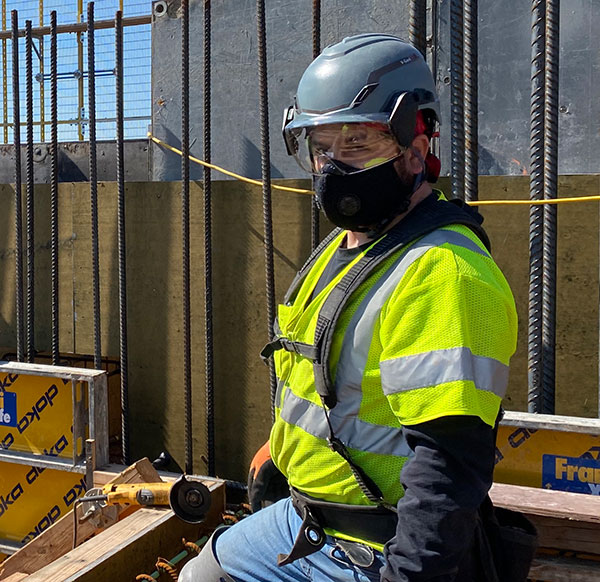
Union worker on the job during the coronavirus pandemic
Those who work in the industry have always known it, but COVID-19 made it clear to the public: construction is essential.
Through thick and thin, the unionized construction industry remains the vital sign of America. These workers erect critical infrastructure — from highways and airports to schools, government buildings, and health-care facilities. During times of crisis, these construction workers possess unique skills to quickly transform non-traditional spaces into critical care centers.
In the midst of this public health crisis and economic downturn, New York City Union Carpenters remained 20,000 members strong. While we couldn’t evade the pandemic’s advance, we met each day united and with a commitment to our members to be union strong. The shield at the base of the emblem in our logo symbolizes that those of us in the union are morally bound to safeguard and protect our members. That is a core value of our union, and during COVID-19 that is what we did.
When New York City was declared a hotspot for the virus, we took a stand and advocated that the government have a strict definition of what was considered essential, ensuring our members and their families remained safe and healthy.
We listened to and communicated with our members. We prioritized worker protections and seized every opportunity to alleviate financial stress. We were there to lend our support, share unemployment resources and protect every member who was out of work with our Benefit Funds.
We strived to ensure our members felt protected during this pandemic, offering supplemental PPE to fill gaps in contractor-provided PPE and providing information on new job site safety protocol and COVID-19 training courses. To guarantee our members’ questions were answered, we held Zoom webinars educating our shop stewards and foreman of the new normal safety standards.
These measures may seem like a no-brainer, yet, at the height of the pandemic, we saw many non-union workers on sites without adequate PPE. Time and time again, the kind of necessary support, expertise, and focus on safety we demonstrated has proven to be exclusive to the unionized construction industry.
When our state’s economy shut down, our union quickly realized that we were building a plane as we were flying it. Construction projects throughout New York City were still operating, and it was up to us to create a blueprint in keeping essential job sites safe.
As we came together with other Building Trades affiliates, contractors, developers, and real estate leaders, we saw that many other unions distributed face masks and provided free COVID-19 antibody testing. Together, we learned from one another and grew stronger.
We believe our industry is only as strong as its weakest link. The District Council will continue to serve as the voice for all workers across New York City, ensuring job sites are meeting or exceeding CDC and OSHA guidelines. The prevailing wage legislation we led the charge on and won in the middle of the pandemic is a testament to this. We advocate for all construction workers, union and non-union alike.
The unionized construction industry has not only built this great city and state but has also willingly and compassionately responded at its times of greatest need and peril. We are proud to be a guiding force and unwavering support system for our members and communities, now and always.
There is a long road to recovery ahead of us, and the New York City & Vicinity District Council of Carpenters will be there every step of the way.
***
Joseph Geiger, the Executive Secretary-Treasurer of the New York City & Vicinity District Council of Carpenters.
***
Have an op-ed idea or submission for Gotham Gazette? Email This email address is being protected from spambots. You need JavaScript enabled to view it.
A Peak Opportunity to Turn the Corner and Invest in Our Green New York Future
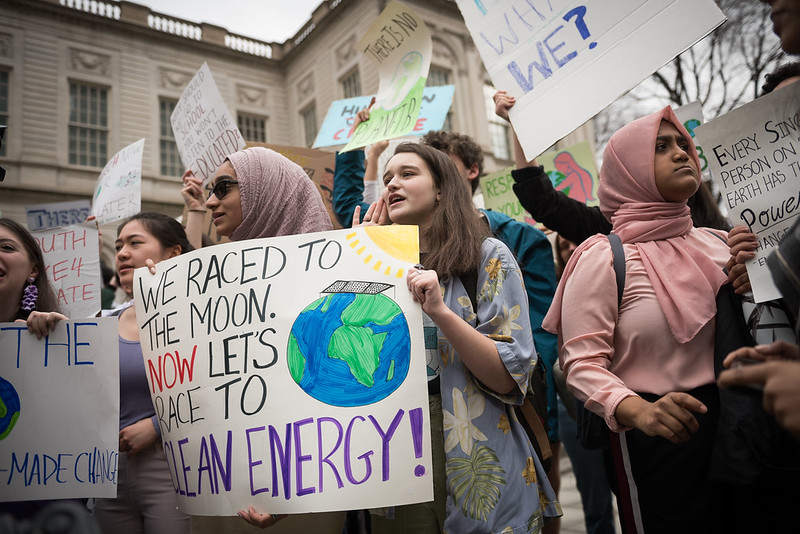
Pushing for a climate plan (photo: Ed Reed/Mayor's Office)
From Superstorm Sandy to Tropical Storm Isaías, climate change threatens all New Yorkers. That policymakers have largely not acted on this threat in a meaningful way is a profound failure. Now is the time to rectify that lack of action.
In New York at least, our new Democratic State Senate majority took power in 2019 and answered the call. Our Climate Leadership and Community Protection Act (CLCPA) is a nation-leading effort to fight back, putting our state on track for net zero greenhouse gas emissions and directing the benefits to communities that the fossil fuel industry left behind.
CLCPA commits New York to an equitable clean energy future – with 70% of electricity being renewable by 2030, 100% carbon-free by 2040, and an 85% emissions reduction overall by 2050. Crucially, at least 40% of investment is reserved for climate justice areas. These ambitious goals are critical, and they are the law. We must do what it takes to win this clean-energy future, secure a livable climate, and fully-fund a just transition for frontline communities.
The Queens waterfront is on the front lines of this battle, simultaneously home to numerous fossil fuel burning plants and NYCHA residents who suffer their effects. These streets are known as “Asthma Alley” due to the high rates of respiratory disease caused by pollution permeating the neighborhood. When everything works as intended at a fossil fuel plant, residents still get hurt. Pollution is no accident—it is a choice we make every time we expand fossil fuel infrastructure.
Neighborhoods nearest to these power plants are also among those hardest hit by COVID-19, the result of several factors including the cumulative impact of pollution, environmental racism, and income inequality driving incidence of respiratory illness. We must take special care to center public health as we consider the energy transition.
Corridors like Asthma Alley are most deserving of protection from the impact of burning fossil fuels, yet some energy companies seem determined to expand their carbon footprints, doubling down on burning fossil fuels that poison the community and heat our planet. With new technology and the CLCPA at the center of a new policy paradigm enabling us to transition away from environmentally hazardous power plants, why would we rubber-stamp new fossil fuel development?
There was a time when incremental progress could be deemed a success—when use of a less dirty but still damaging fuel may have been considered a step in the right direction. Insofar as using natural gas as a bridge to a renewable energy future was ever good policy, surely it has been spanned. The future is now. The work to meet the requirements of CLCPA and imbue New York energy policy with environmental justice has begun.
We know that once fossil fuel plants are built, they are difficult to decommission. In 2001, the New York Power Authority (NYPA) managed to eschew standard land-use protocols by claiming that emergency power plants were needed temporarily. NYPA pledged these plants would fire for only three years. Some of us sued to stop these “temporary” plants - and we won - but the plants remain operational nearly 20 years later.
Now there is a proposal to construct a natural gas ‘peaker plant’ in Astoria. Peaker plants feed the city additional power in times of high demand, running a relatively small number of days per year but requiring substantial fuel stores. And while natural gas is cleaner than kerosene, it is still a fossil fuel that does not move us quickly enough toward meeting the Earth-saving requirements of CLCPA.
Climate justice demands bold action now. CLCPA has raised the bar and we must meet it. This peaker plant proposal must be opposed. Despite game-changing laws like CLCPA, if this plant is built, like the wave of peakers constructed at the beginning of this century, we can expect it to remain in operation for decades. Even if we add renewable capacity after it is built, there will be pressure to keep it firing—and polluting—in order to make good on the investment required to build it and others.
In other words, new fossil fuel projects diminish our tenuous carbon budget and may be fiscally irresponsible on timelines that count: not financial quarters but over the lifetime of a capital investment and the lifetimes of people breathing polluted air.
The so-called “Astoria Replacement Project” needs replacing. Scrapping the proposal and focusing instead on clean power, innovative battery storage, and community empowerment will help meet the need to supercharge our energy policy in a just fashion. Let us muster the political courage necessary to force utilities to harness a clean alternative using an equitable process as quickly as they aspire to slip into our neighborhoods one of the last polluting power plants the law is likely to permit. Let us take this opportunity to refocus our energy economy towards public good and away from big corporations whose primary concern is the short-term profits of their executives and shareholders.
Think of the possibilities – for communities to reclaim open space, secure truly affordable housing, and win career-long green jobs – if solar fields, wind turbines, innovative battery storage, and community-owned renewables supplant dirty electricity. Let us think big and explore the possibility of placing the growing numbers of unemployed into workforce training that directly leads to well-paying jobs that stand the test of time. Let us build out a clean, electrified power sector so we can decarbonize the economy while advancing public health and frontline empowerment at every turn, ensuring that, for example, New Yorkers who drive can exchange their polluting tailpipe vehicles for electric cars.
We need to treat the energy industry as an integrated part of our overall economy and empower communities to harness it to provide sustainable job opportunities and environmental justice to their resilient neighborhoods. We need to seize the present opportunity to deliver on our commitment to clean energy and climate justice by stopping this misguided proposal for another peaker plant in Astoria.
***
Michael Gianaris serves as Deputy Majority Leader and represents western Queens in the state Senate. Harry Manin is a Sunrise NYC activist and climate policy advisor. On Twitter @SenGianaris and @sunrisemvmtnyc.
***
Have an op-ed idea or submission for Gotham Gazette? Email This email address is being protected from spambots. You need JavaScript enabled to view it.




